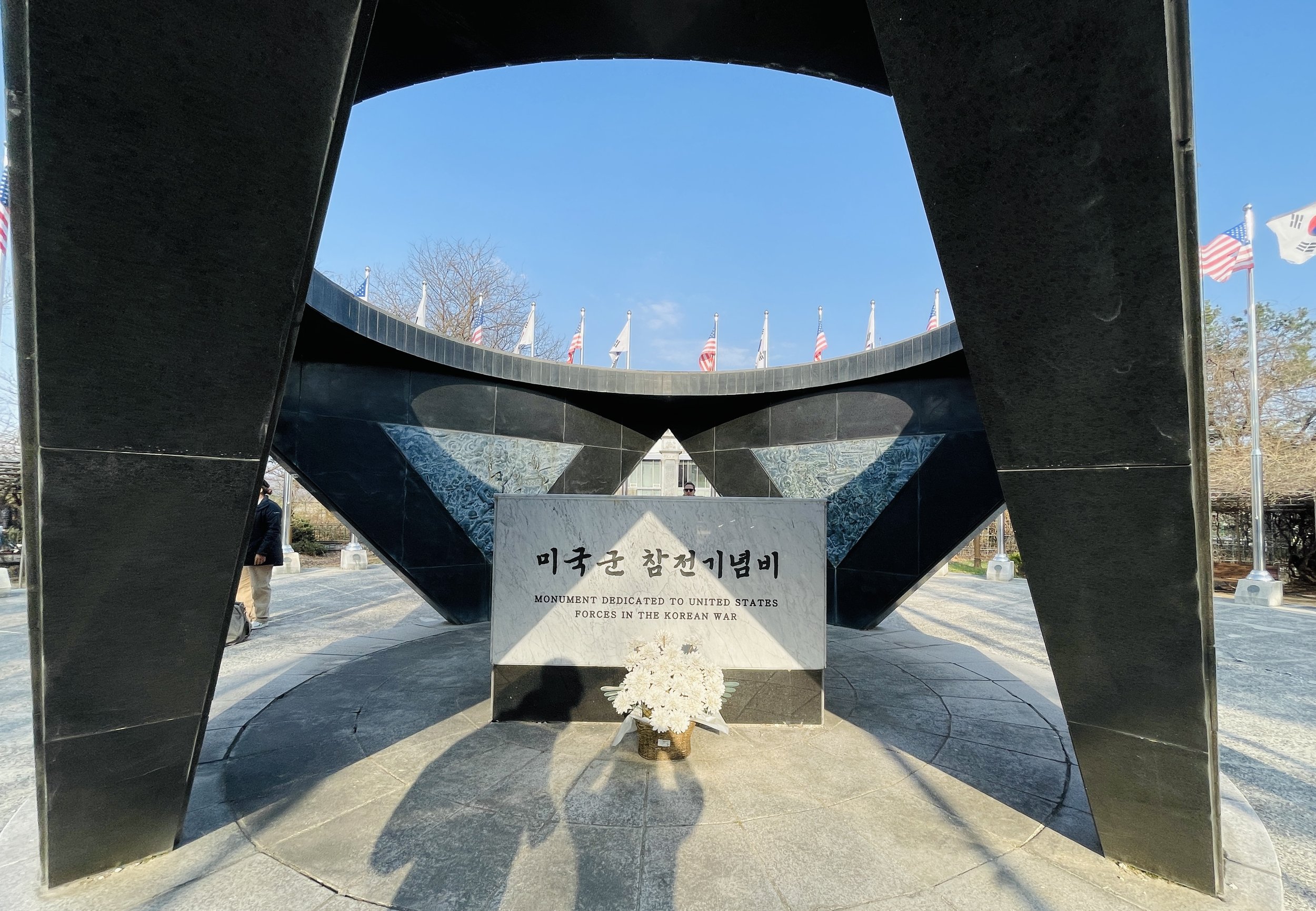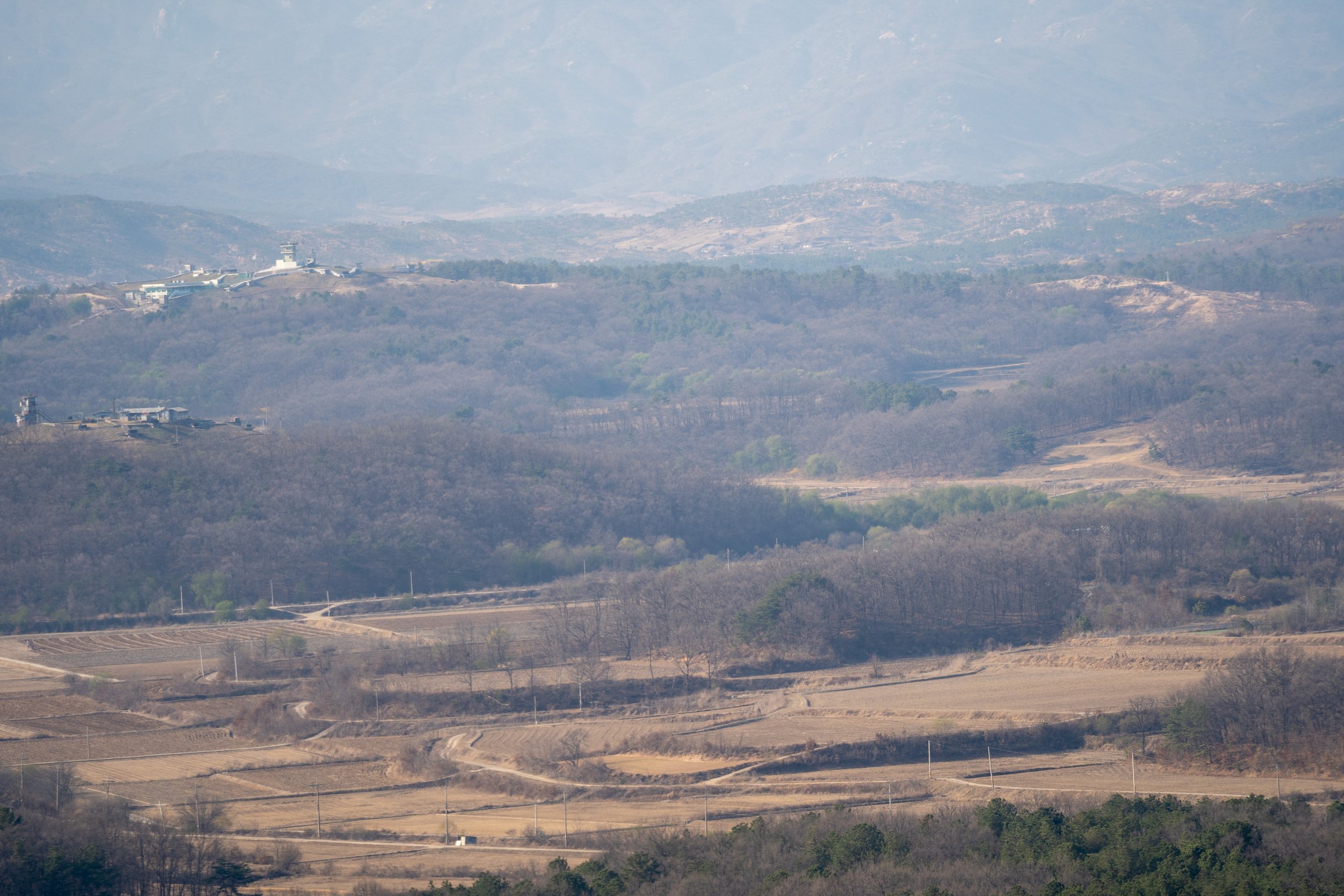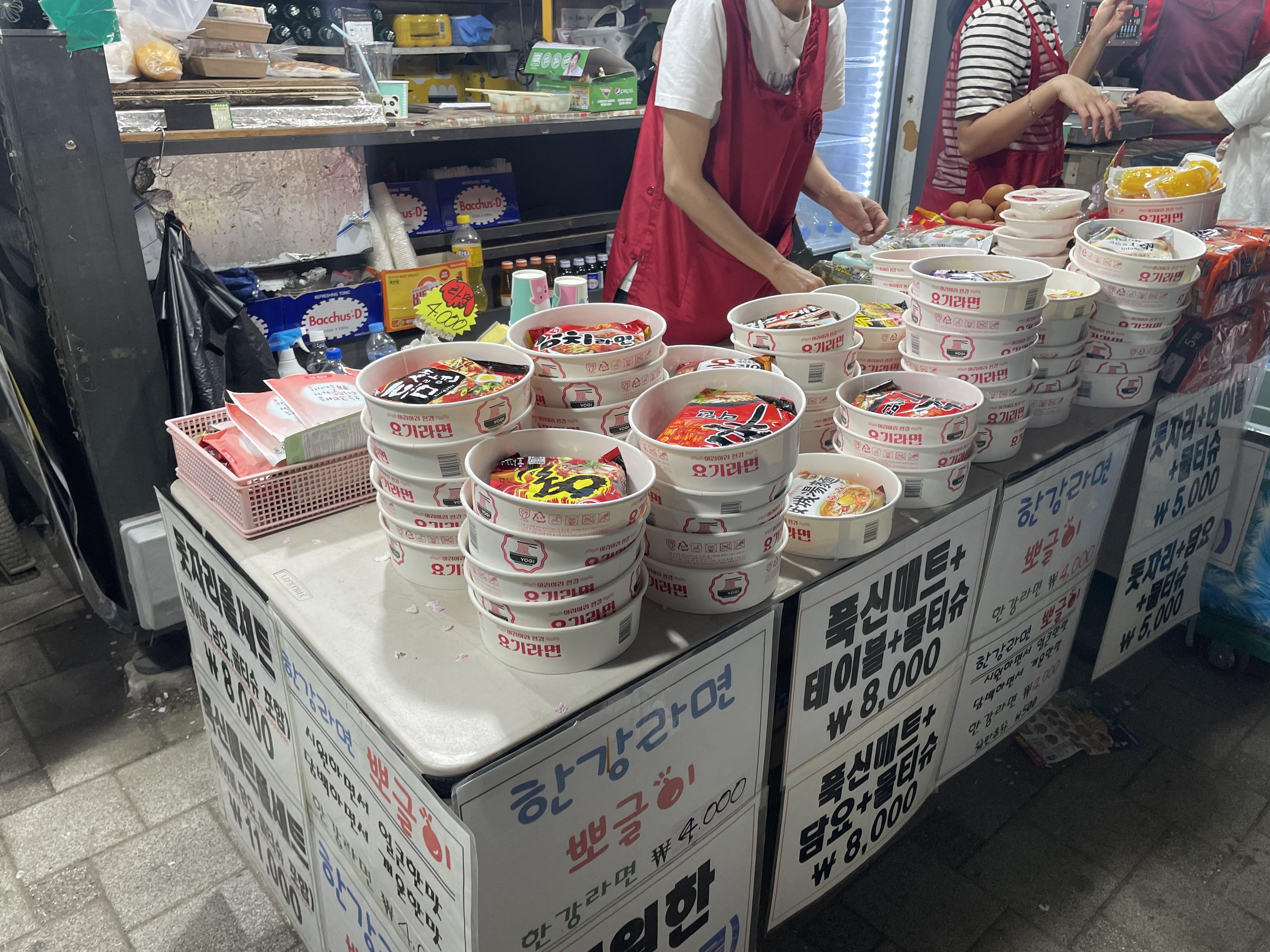DMZ, Korean 非军事区
April 1: We left home on March 31 and flew to Seoul, South Korea, with a layover in Honolulu. Direct flight from the U.S. mainland to Asia usually takes between 12 to 15 hours these days, which becomes too long for our aging bodies. We tried to find a better way to handle the long journey. We booked Hawaiian Airlines in Economy Cabin but upgraded to the exit row with extra legroom. The wide-body jet usually has ample open space at the exit door. The flight was still long, about 7~8 hours for each segment, but since we had a stop at Honolulu in the middle of the flight and with the extra legroom, the flight was not too bad.
After a 23-hour-long journey, we finally arrived in Seoul, the capital of South Korea, on the evening of April 1. Our hotel was in Myeongdong district, the city center, but the Incheon International Airport was far away from the city. The express train from the airport to Seoul Station was convenient. The hotel reception was entirely replaced by robots, not a single person in sight. We checked in with the robot and our room was the smallest hotel room we ever had stayed. After dropping off our luggage, we ventured out to the nearby Myeongdong Night Market. We ordered grilled octopus, grilled beef, and stir-fried potato noodles, and although the taste was good, the prices were a bit higher than the dishes in the nearby small restaurants.










April 2: We had to wake up early before 6 am and boarded a tourist bus to visit the Demilitarized Zone (DMZ) on the 38th parallel. When we booked the tickets, the meeting time was initially scheduled for 7 am, but it was changed to 6 am after payment. We arrived at the Imjingak Pyeonghwa Nuri Park a little after 7, and already more than a dozen buses were parked in the parking lot. It seemed that others had woken up even earlier. We met a Dutch couple who said they gathered to leave the city at 5 am. The tour guide collected our passports and rushed to the ticket office to buy tickets. After thirty minutes, he returned and said the tickets were purchased and we would enter the DMZ at 2:30 in the afternoon. However, the ticket office wouldn't open until 9 am, so he must have arranged for someone to queue up and buy tickets for us.
Before heading to the DMZ, we had six hours to spare. We first strolled around the Imjingak part of Imjingak Pyeonghwa Nuri Park, the memorial area, and had breakfast. Imjingak Park has many statues and monuments regarding the Korean War, including Mangbaeddan, Monument to US Forces in the Korean War, Peace Train, and a bunker. There is also a selection of restaurants and an observation deck.











Then they drove us to the nearby Suspension Bridge Park to enjoy the beautiful scenery. We made a short stop at the Gloster Hill Memorial Park, commemorating the Gloucestershire Regiment's actions during the Battle of the Imjin River during the war. The original memorial and the recent expansion of the park are both thoughtfully designed and emotionally stirring.




Another memorial dedicated to the Gloucester Regiment, Gloucester Heroes Bridge, is not too far from the Memorial Park. The suspension bridge, which is over 220m long and 10m high, is the longest in South Korea. A small but quite beautiful Buddhist temple is on the hill at the end of the bridge. We did manage to climb up the mountain to visit the temple and back down to board the bus on time.








Returning to the park, we had lunch and continued leisurely walking on the other side, Pyeonghwa Nuri Park, also known as Peace Nuri Park. It is an extension of Imjingak Park and focuses on promoting peace and reunification. It features sculptures, art installations, and exhibition halls conveying peace and unity messages. We were fortunate to have good weather, with many people flying kites, young people camping and having picnics on the lawn, and even a music concert and amusement park. The colorful pinwheels were enjoyable to see. We sat there, drank coffee, and enjoyed the lively atmosphere.















The tour guide repeatedly emphasized the importance of returning to the bus on time for the DMZ. Finally, we arrived at the entrance of the DMZ. South Korean soldiers boarded the bus and checked our passports before the bus entered the control area. Our first stop was the Third Tunnel. It is said that North Korea had prepared sixteen tunnels to invade South Korea, and four of them have been discovered. The Third Tunnel is open to the public, and the tour guide jokingly mentioned that North Korea was so poor because they spent so much money on digging the tunnels, only for others to profit from them. Inside the tunnel, taller individuals had to stoop while walking, and we could constantly hear the sound of safety helmets hitting the ceiling. Chenggang was one of the victims. After the tunnel visit, we visited an observatory on the mountaintop to glimpse North Korea on the other side. With the clear weather, we could see people walking around the North Korean town through the telescope. Finally, in the Unification Village, we enjoyed some local soy milk ice cream, which tasted delicious.













The tour guide was amiable and well-informed, providing insightful information throughout the trip. However, he had a persistent cough that continued throughout. We sat in the front row, right beside him. During the return journey, he confided in us, revealing that he had contracted Covid a month ago and was still struggling to recover fully, mainly because he had lost his sense of smell. This revelation left us uneasy, but we allowed ourselves to relax a bit, assuming that we were adequately protected by our vaccination shots and had yet to contract the virus. We believed that we were somehow immune to the dangers of Covid.
After returning to Seoul, we went directly to a park along the Han River to see the cherry blossoms. Upon exiting the subway station, we found the place crowded with people. The lawn were fully occupied, and there were long queues to buy snacks. Young people stood in line to buy a bowl of instant noodles and sat on the ground to eat, embracing the ambiance. As elderly folks, we decided not to join the crowd and quickly returned to Myeongdong. We found a small restaurant near our hotel and enjoyed our favorite hot stone pot rice, seafood pancakes, and tofu soup. After the meal, we returned to our room to rest, knowing we had to wake up early the next day to continue our journey.





4/1: 经过整整二十三小时长途旅行后,在四月一号晚上到达韩国首都首尔。入住旅馆的前台完全被机器人代替了,一个人影都没有。放下行李后便马不停蹄地去了附近的明洞夜市,烤章鱼,烤牛肉和炒粉条各要了一份,味道还不错就是价格高了一点,比附近的小饭店里的菜还要贵。
4/2: 早早起床六点就上了旅游大巴去三八线的非军事区(DMZ)参观,订票时说是七点集合,钱付完后改成六点了,说是为了赶着买进非军事区的票。我们七点多一点就到和平公园,停车场上已经有十几辆大巴,看来别人比我们还早起,碰到一对荷兰的老外说他们五点集合离城的。导游把我们护照收起,赶着去售票处买票。过三十分钟后他回来说票买好了下午二点半进非军事区。但是售票处要九点才开,估计他肯定是找黄牛排队买票的。
在去非军事区前我们有六个小时打发,先在和平公园的纪念区转转,吃了个早点,然后去附近的吊桥公园看看,风景不错,我们还爬山去了山里的寺庙。再次回到和平公园,吃个午饭,接着在公园另一边走走,那里主要是当地人带孩子们休息玩耍的地方。正好赶上个好天气,好多人在放风筝,年轻人在草坪上搭上帐篷露营野餐,还有音乐会,游乐场。我们就在那里喝咖啡看热闹。
导游一再强调我们必须准时回大巴前往DMZ。终于来到非军事区的入口处,韩军小兵上车检查护照后,我们先去了第三隧道参观。据说北朝为了攻克南朝一共准备挖十六隧道,到目前为止已发现了四条。第三隧道对外开放,导游开玩笑说北朝所以穷就是花了那么多钱挖隧道,结果都让别人用来赚钱了。隧道里人高的必须弯腰走,一路就听见安全帽撞击的声音。隧道岀来又去山顶上的望远楼看看北朝鲜那一边。天气好,从望远镜里可以看到对面北朝鲜小镇上人走来走去。最后在统一小镇上吃上当地大豆冰淇淋,味道不错。
回到首尔后又直接去了汉河边的公园看樱花。出了地铁站后发现那里人山人海,草地全坐满人,买小吃都要排长队,年轻人排着长队买一碗泡面坐地上吃,他们要的是情调。我们老头老太就不凑热闹了,赶回明洞区,在旅馆边找了家小店,吃我们喜爱的石锅饭,海鲜饼和豆腐汤。饭后回房休息,明天又要早起继续我们的旅程。





